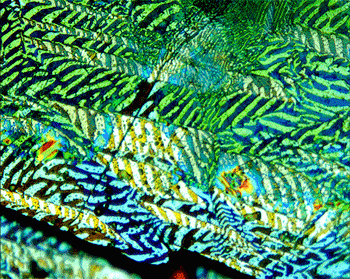| May 10, 2019 | |
2D insulators with ferromagnetic properties are rare; researchers just identified a new one(Nanowerk News) Collaborating scientists at the U.S. Department of Energy’s Ames Laboratory, Brookhaven National Laboratory, and Princeton University have discovered a new layered ferromagnetic semiconductor, a rare type of material that holds great promise for next-generation electronic technologies (Advanced Materials, "Ferromagnetic Semiconductors: VI3 – a New Layered Ferromagnetic Semiconductor"). |
|
| As the name implies, semiconductors are the Goldilocks of electrically conductive materials-- not a metal, and not an insulator, but a “just-right” in-between whose conducting properties can be altered and customized in ways that create the basis for the world’s modern electronic capabilities. Especially rare are the ones closer to an insulator than to a metal. | |
 |
|
| Magneto-optical characterization of ferromagnetic domains in VI3, a recently discovered layered ferromagnetic semiconductor. (Image: Ames Laboratory) | |
| The recent discovery of ferromagnetism in semiconducting materials has been limited to a handful of mostly chromium-based compounds. But here, the researchers discovered ferromagnetism in a vanadium-iodine semiconductor, a material which has long been known but ignored; and which scientist Tai Kong compared to finding a “hidden treasure in our own backyard.” | |
| Now a postdoctoral researcher in the lab of Robert J. Cava, the Russell Wellman Moore Professor of Chemistry at Princeton University, Kong completed PhD research at the Ames Laboratory under supervision of Paul C. Canfield. And when new material could have ferromagnetic response, Kong turned to Ames Laboratory for the magneto-optical visualization of magnetic domains that serves as the definitive proof of ferromagnetism. | |
| “Being able to exfoliate these materials down into 2D layers gives us new opportunities to find unusual properties that are potentially useful to electronic technology advances,” said Kong. “It’s sort of like getting a new shape of Lego bricks. The more unique pieces you have, the cooler the stuff you can build.” | |
| The advantage of ferromagnetism in a semiconductor is that electronic properties become spin-dependent. Electrons align their spins along internal magnetization. | |
| “This creates an additional control knob to manipulate currents flowing through a semiconductor by manipulating magnetization, either by changing the magnetic field or by other more complex means, while the amount of current that can be carried may be controlled by doping (adding small amount of other materials),” said Ames Laboratory Scientist Ruslan Prozorov. “These additional ways to control behavior and the potential to discover novel effects are the reason for such high interest in finding insulators and semiconductors that are also ferromagnets.” |
| Source: Ames Laboratory | |
|
Subscribe to a free copy of one of our daily Nanowerk Newsletter Email Digests with a compilation of all of the day's news. |
